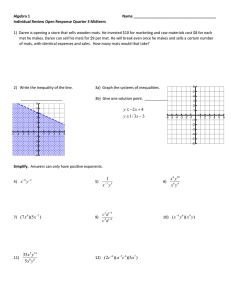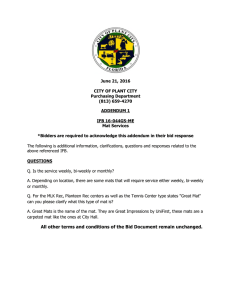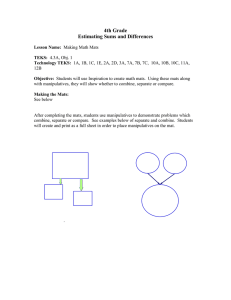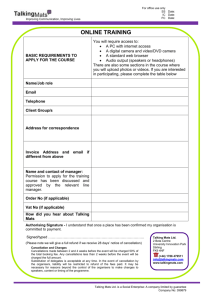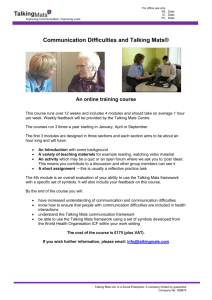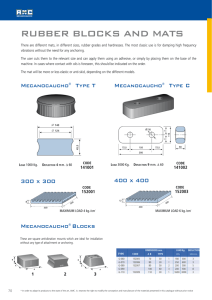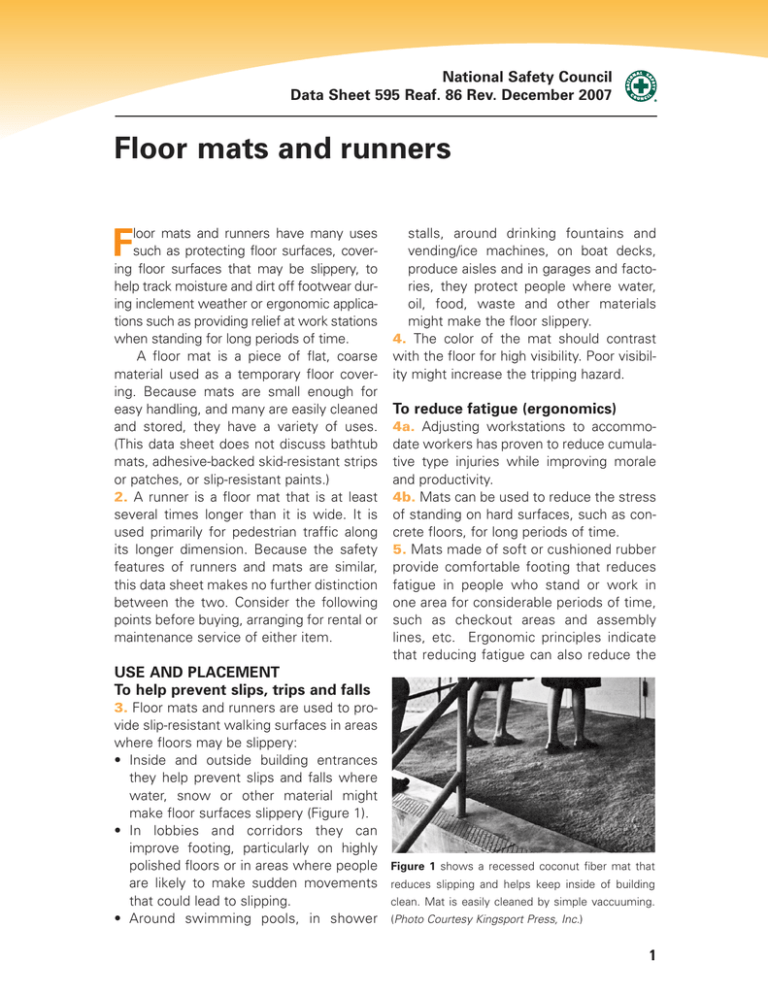
National Safety Council
Data Sheet 595 Reaf. 86 Rev. December 2007
Floor mats and runners
loor mats and runners have many uses
such as protecting floor surfaces, covering floor surfaces that may be slippery, to
help track moisture and dirt off footwear during inclement weather or ergonomic applications such as providing relief at work stations
when standing for long periods of time.
A floor mat is a piece of flat, coarse
material used as a temporary floor covering. Because mats are small enough for
easy handling, and many are easily cleaned
and stored, they have a variety of uses.
(This data sheet does not discuss bathtub
mats, adhesive-backed skid-resistant strips
or patches, or slip-resistant paints.)
2. A runner is a floor mat that is at least
several times longer than it is wide. It is
used primarily for pedestrian traffic along
its longer dimension. Because the safety
features of runners and mats are similar,
this data sheet makes no further distinction
between the two. Consider the following
points before buying, arranging for rental or
maintenance service of either item.
F
stalls, around drinking fountains and
vending/ice machines, on boat decks,
produce aisles and in garages and factories, they protect people where water,
oil, food, waste and other materials
might make the floor slippery.
4. The color of the mat should contrast
with the floor for high visibility. Poor visibility might increase the tripping hazard.
To reduce fatigue (ergonomics)
4a. Adjusting workstations to accommodate workers has proven to reduce cumulative type injuries while improving morale
and productivity.
4b. Mats can be used to reduce the stress
of standing on hard surfaces, such as concrete floors, for long periods of time.
5. Mats made of soft or cushioned rubber
provide comfortable footing that reduces
fatigue in people who stand or work in
one area for considerable periods of time,
such as checkout areas and assembly
lines, etc. Ergonomic principles indicate
that reducing fatigue can also reduce the
USE AND PLACEMENT
To help prevent slips, trips and falls
3. Floor mats and runners are used to provide slip-resistant walking surfaces in areas
where floors may be slippery:
• Inside and outside building entrances
they help prevent slips and falls where
water, snow or other material might
make floor surfaces slippery (Figure 1).
• In lobbies and corridors they can
improve footing, particularly on highly
polished floors or in areas where people
are likely to make sudden movements
that could lead to slipping.
• Around swimming pools, in shower
Figure 1 shows a recessed coconut fiber mat that
reduces slipping and helps keep inside of building
clean. Mat is easily cleaned by simple vaccuuming.
(Photo Courtesy Kingsport Press, Inc.)
1
National Safety Council
Data Sheet 595 Reaf. 86 Rev. December 2007
possibility of injuries and improves general work efficiency.
5a. The proper amount of cushioning is
important. Use a mat with good support, one
that is not too soft, which could require more
energy to use (similar to standing in sand).
6. Special foot-warming mats with built-in
heating elements (listed by Underwriters
Laboratories, Inc.) are available to provide
comfort for people who must stand in cold
climates.
To protect other surfaces
7. Because many mats are easily cleaned
or replaced, they often serve as economical protective coverings that reduce wear
on floor and stairway surfaces, rugs and
carpets, and smooth-surfaced floor coverings. Mats also protect floors and floor coverings from water, oil, dirt and grime.
8. Many types of mats have surfaces that
help remove substances from shoes. Such
mats reduce the amount of slippery, harmful or contaminant material tracked onto
other floor surfaces. Doormats and other
mats specifically designed to remove dust,
water and other substances from shoe
soles are widely used in offices, residential
buildings, industrial establishments and
retail establishments (Figure 2).
8a. Carpeted entryways are an effective
way to remove moisture from footwear
during inclement weather. Both mats and
carpet should be designed with enough
walk-off distance to remove moisture from
footwear. A mat may need to be changed
out during the day if it becomes saturated.
To reduce noise and breakage
9. Cushioned mats reduce traffic noise and
breakage when items are dropped. These
mats are particularly useful in restaurants,
hospitals, electronic and glassware plants,
offices and supermarkets.
To prevent electric shock
10. Special heavy-duty rubber mats, with
high dielectric strength, insulate employees from electric shock at switchboards
and around other electrical equipment.
For multiple uses
11. Some applications require mats with
multiple characteristics. For example, a
mat for use in a food service kitchen should
be easily cleaned, sanitary, economical,
durable, slip-resistant and resistant to
water and grease. It should minimize
breakage or damage to glassware, cutlery
and knives. In addition, it should lie flat and
should be easy to move, store and replace.
12. Indoor-outdoor carpeting is used in
Figure 2 illustrates a heavy-weight rubber mat with a nubby finish.
These lie flat and stay in place. They can be rotated to distribute wear
and minimize “bald” spots.
2
National Safety Council
Data Sheet 595 Reaf. 86 Rev. December 2007
many areas where mats and runners were
formerly used.
HAZARDS
13. While mats and runners can help
reduce hazards, improper use can introduce
new loss exposures. The potential hazards
associated with using mats and runners are
described in the following paragraphs.
Tripping hazard
14. Mats, especially lightweight types, can
be torn by handling or excessive wear. The
resulting loose or raised areas can catch
footwear, creating tripping hazards. Mats
that have been moved and not properly relaid may develop curled or raised edges,
which also create tripping hazards. Mats
that are not laid flat or fastened securely
may pucker, causing toes or heels to catch,
leading to falls. (Mats may have inflexible
edge bevels to prevent curling but they
cannot roll up.)
15. When single-tread mats are used on
stairs they may tear or work loose, creating
tripping hazards.
16. When possible, thick mats—made of
such materials as thick coconut fiber or
heavy corrugated rubber—should be
recessed with edges closely fitted to eliminate raised edges. Where necessary,
drainage should be provided in the recess.
If recessing is not possible, mats should be
finished with wide, beveled edges, or
should be set in a beveled-edge frame to
minimize tripping and heel catching. Some
companies highlight their mats by using
contrasting colors on the beveled edges.
17. Adequate lighting is necessary to further minimize the tripping hazard.
Slipping hazard
18. Grease or water can make mat sur-
faces slippery. Also, when mats are not
suited to the surfaces they cover or are laid
with the wrong side down, they may slip,
creating greater hazards than the surfaces
they cover. To prevent movement a mat
should be heavy enough and its bottom
made of or covered with slip-resistant
material. A double-sided tape affixed to the
back of the floor mat also can prevent slipping. The mat could also be taped down if
used on a temporary basis.
Miscellaneous hazards
19. Poorly designed and placed mats create other hazards. Mats that are too large
or too heavy may strain employees who
roll, lift, or move them. Sharp edges on
metal parts of mats may cause cuts.
Wooden parts may splinter or break, leaving a raised or sharp edge. Open-link mats
may present a hazard to individuals wearing high heels; the heels can catch in the
openings and cause falls. Mat designs that
contain high ridges may present hazards
because they do not provide stable footing.
20. When selecting mats or runners, consider ease of handling. Heavy types may
require special moving and storing techniques. They may present special hazards if
not handled by enough trained workers
using low trucks, dollies, or other appropriate equipment.
21. Proper handling can sometimes correct problems. For example, if a mat has a
tendency to curl, turning it over before it is
rolled up may reduce curling when the mat
is reused.
22. It is also necessary to select the appropriate number and size of mats or runners
for your desired location. Having too many
mats in an area can create unnecessary
elevation changes and disrupt people’s natural walking pace.
3
National Safety Council
Data Sheet 595 Reaf. 86 Rev. December 2007
plants. Mats used in such areas should be
designed to allow water, oil and other slippery substances to drain through openings
and not accumulate on the top surfaces.
25. Wooden mats can be lifted easily or
moved to allow both the floor and the mat
to be cleaned. Durable construction permits frequent and thorough cleaning of the
mat itself. Abrasive tapes or coatings can
be added to the slats, providing a rough
surface that is not easily made slippery by
spilled fat.
Figure 3 shows the use of cushioned rubber mats in
Rubber mats
a locker room.
26. Rubber mats and runners are useful
where resistance to water, rather than oil,
is required. They are used in the entrances,
passageways and hallways of office buildings, factories, hotels, restaurants, department stores and supermarkets. Rubber
mats and runners are also used in locker
rooms and around swimming pools.
Rubber mats are widely used where electrical isolation is important.
27. Rubber mats come in a wide variety of
patterns and thicknesses. Patterns may
contain corrugations or ribs running lengthwise, crosswise or diagonally. Basket
weave effects, raised knobs, perforations
and simulated carpet textures also are
available. Corrugated or ribbed surfaces are
generally used for one-direction traffic; perforated, knobby, or basket weave designs
are used for traffic in all directions.
28. Rubber mats are also made with openlink and tight-link (no opening) construction.
Some link mats are reversible, permitting
use of both slip-resistant surfaces.
Perforations or open spaces discourage
accumulation of dirt and debris on the mat
surface, but shoe heels are less likely to
catch in tight link mats. Continuous travel
of shopping carts over rubber mats with
open or tight links tends to bend the wire
TYPES OF MATS
Wooden Mats
Duckboards (type of wooden mats) are
used in plating and fabrication shops and
other applications to provide dry footing in
a wet or dirty environment. In addition,
wood mats are used in saunas, steam
rooms, hot tubs, marinas, boat docks/boat
yards and similar areas.
22. Wooden mats and runners may be
rigid or flexible. Rigid wooden mats (or
duckboards) should be built in sections that
can be handled easily by one worker. They
should be made of long-grained hardwood,
which may be chemically treated to prevent rotting and warping. Rigid mats are
nailed, bolted or joined with wood screws
to crosspieces.
23. Flexible wood mats are joined by stainless steel rope, nylon rope, rust-resistant
springs or other oil- and water-resistant connectors that permit the mat to be rolled up.
24. Wooden mats are used over floors in
areas that are often wet and slippery. Such
conditions are common in food service
kitchens, shower rooms, food processing
plants, and many other manufacturing
4
National Safety Council
Data Sheet 595 Reaf. 86 Rev. December 2007
very durable, they are widely used outdoors and at building entrances.
32. Flexible metal mats are easily rolled up
and cleaned.
Coconut fiber mats
Figure 4 is an open-link rubber mat, which can help
reduce fatigue.
linkage, causing the mat to warp and buckle. Frequently check the condition of mats
used in such areas.
29. Cushioned rubber mats combine a relatively tough wearing surface with a soft,
sponge-rubber, inner-core design that prevents fatigue. Edges are beveled to reduce
the tripping hazard. Cushioned mats may
not be the best choice for areas where
users walking on these mats wear thin or
high-heeled footwear.
33. Thick, brush-like mats made of
coconut fiber absorb considerable moisture
and provide a good surface for cleaning
shoe soles. They withstand hard wear and
are slip-resistant. A thinner, woven fiber
matting is used in locker rooms and around
swimming pools, where water absorbency,
rather than durability, is needed. However,
coco-fiber mats may be difficult to sanitize.
Because they absorb moisture, fiber mats
are not suitable for use when freezing temperatures cause ice to form.
Vinyl and neoprene mats
30. Mats made of vinyl, neoprene or similar synthetic material have slip-resistant,
resilient surfaces that are resistant to
grease, oil, chemicals, water and extreme
temperatures. These mats are recommended for use in front of machinery and
in chemical laboratories, plants and
kitchens. Their construction is similar to
that of rubber mats.
Figure 5a illustrates the use of fabric or cotton mats
at entrances to absorb moisture and dust, but they
do require surveillance to minimize potential tripping
hazards.
Flexible metal mats
31. Aluminum or rust-resistant steel mats
are made of metal ribbons or links that are
woven or fastened together with rods,
springs or tempered wire. Metal mats are
about 1⁄8 in. (9.5 mm) deep, providing excellent shoe-scraping surfaces from any direction. They are used to remove mud, grime
and grease from shoes. Because they are
Figure 5b shows how a person can trip on a raised
portion of such a mat. To remedy: lay mat flat and
fasten securely.
5
National Safety Council
Data Sheet 595 Reaf. 86 Rev. December 2007
Combination materials
34. Mats that are similar to lightweight carpeting and made of cotton, viscose or
nylon pile are available with rubberized
backs, or they can be inserted into rubber
or vinyl frames to keep them in place.
35. Some combination mats are made of
tire cord strips or links fastened together
with metal rods or links. A combination of
metal and wood or fabric links is used in
entranceways where removal of water and
dirt is important. These mats provide
enough cushioning to reduce fatigue, and
the materials used are more durable than
sponge rubber. The open construction provides good shoe-cleaning action.
36. An exceptionally durable mat made of
fabric-reinforced neoprene is slip- and fireresistant and withstands the harmful effects
of grease, fat, heat, chemicals and water.
37. Mats are available with safety messages woven into the mat design.
37a. Major mat rental companies are a
resource in the selection of type, material
and mat maintenance programs.
Alternatives to Mats
37a. Fixed-carpet entryways are an alternative to using mats in a high-traffic
entrance. The carpet provides a transition
between the outside and interior walking
surfaces while absorbing moisture during
inclement weather conditions. The length
of the carpet needs to be long enough to
remove the water from pedestrian’s feet
before reaching the regular floor.
37b. Patterned concrete with ridges or
grooved asphalt, or other similar surfaces, provides traction during inclement weather for
both interior and exterior applications such as
walkways in permanent amusement parks.
Economic Factors
38. When selecting a mat, consider not only
the initial cost, but also the cost of cleaning
the mat and the surface that the mat protects
as well as the durability of the mat and the
savings in maintenance and wear costs for
the surrounding surfaces. For example, a
lightweight fabric walk-off mat and a heavyduty mat may have the same initial cost. The
lightweight mat is less durable but because it
is easier to clean it reduces the need to clean,
wax and refinish adjacent floor surfaces.
Overall, in this case, the reduced maintenance may justify the seemingly high cost of
the lightweight mat. Likewise, a small,
recessed, highly absorbent, heavy-duty mat
used in a building entrance or elevator may
reduce maintenance of waxed floors and
contamination of other carpets and floor surfaces, thus returning its initial cost and the
cost of recessing many times over.
Control measures
39. Establish specific definite procedures
for placing, cleaning, removing and storing
mats. Employees who put mats in place
during inclement weather need clear
instructions as to where and when mats
should be put down and removed. Delays
in putting mats down or placing them too
close to doors may result in slippery
entrance areas and allow water and dirt to
be carried beyond the entrance, creating
hazards and maintenance problems in
another area.
40. Develop specific procedures for inspecting and checking the condition of mats and
for maintaining them in safe condition.
41. Personnel should be trained to keep
mats in safe condition. For example, scrap
lumber or soft wood should never be used
to repair duckboard slats.
42. Employees should be instructed to
report unsafe conditions, as soon as possible, such as tears, upturned edges, splinters in wooden mats or broken connectors.
6
National Safety Council
Data Sheet 595 Reaf. 86 Rev. December 2007
They should know how and where to
report such conditions and should make a
practice of straightening mats or eliminating other mats hazards whenever possible.
43. Everyone involved should understand
the policy and procedures required in the
event of an accident or incident involving a
mat. Note the condition of the mat on the
accident and claim report forms.
44. Inspection checklists should include
points on mat placement and condition.
This information can help to reduce hazards
and also will be valuable in the investigation of accidents involving mats.
Copyright ©2008 National Safety Council.
All rights reserved.
Although the information and recommendations contained in this publication have been compiled from
sources believed to be reliable, the National Safety
Council makes no guarantee as to, and assumes no
responsibility for, the correctness, sufficiency or
completeness of such information or recommendations. Other or additional safety measures may be
required under particular circumstances.
Acknowledgment
This data sheet was revised by the
Services, Retail & Logistics Section of the
Business and Industry Division, National
Safety Council, 1121 Spring Lake Drive,
Itasca, IL 60143.
7

